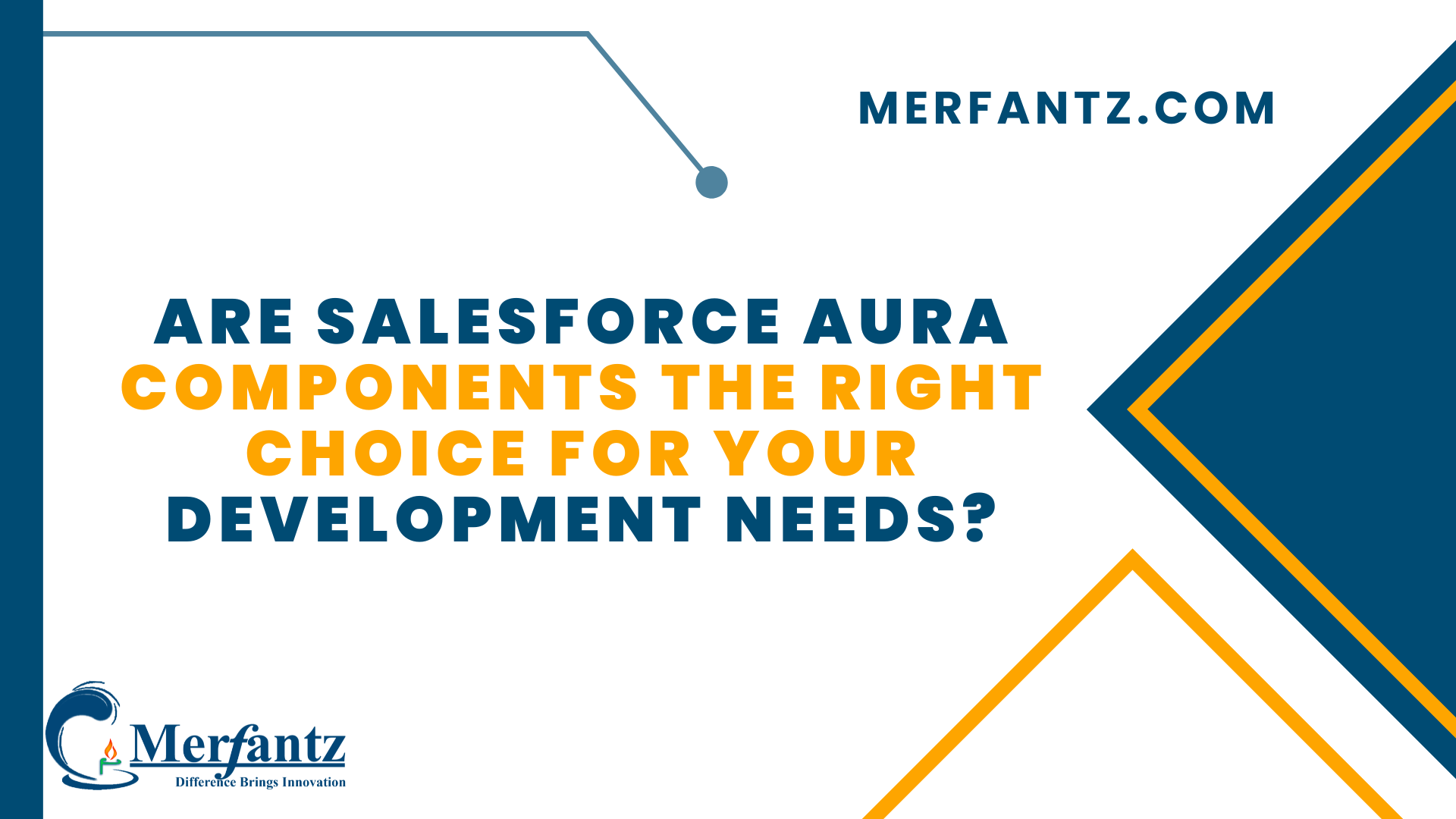Introduction to Salesforce Aura Components
Salesforce Aura Components stand at the forefront of modern application development within the Salesforce ecosystem. They serve as building blocks for creating dynamic, interactive, and visually appealing user interfaces. As a comprehensive framework, Aura Components enable developers to craft seamless experiences that align with business objectives.
At Merfantz Technologies, we recognize the significance of harnessing the potential of Salesforce Aura Components. By employing a component-based architecture, developers can achieve higher levels of reusability and modularity, thereby streamlining the development process. In this blog post, we delve into the advantages, use cases, and considerations associated with Salesforce Aura Components, equipping you with the insights needed to make informed development decisions.
Advantages of Salesforce Aura Components
Salesforce Aura Components offer a host of advantages that contribute to efficient and effective application development within the Salesforce ecosystem. These advantages encompass enhanced user experience, streamlined development processes, and the ability to create sophisticated user interfaces tailored to specific business needs.
- Modular and Reusable: Aura Components follow a component-based architecture that encourages modularity and reusability. This means that developers can create self-contained building blocks that encapsulate specific functionality, making it easy to reuse these components across different parts of an application or even in different applications altogether.
- Interactive User Interfaces: One of the primary strengths of Aura Components is their ability to create dynamic and interactive user interfaces. By enabling real-time updates and responsiveness to user actions, Aura Components enhance user engagement and overall satisfaction, leading to more productive user interactions.
- Event-Driven Communication: Aura Components facilitate seamless communication between different components through events. This event-driven model allows components to interact with each other without tightly coupling their functionality. This decoupling leads to more maintainable and scalable codebases.
- Consistency and Design Patterns: Aura Components provide a consistent and standardized way to develop user interfaces. This promotes adherence to design patterns and user experience guidelines, ensuring that the application maintains a cohesive and professional look and feel.
- Integration with Salesforce Data: Aura Components seamlessly integrate with Salesforce data and services. This means that developers can easily fetch, manipulate, and display data from Salesforce objects, enabling the creation of data-driven and contextually relevant user interfaces.
- Security and Compliance: Aura Components inherit the security features of the Salesforce platform. This ensures that data security and compliance requirements are upheld, providing a secure environment for both users and developers.
- Declarative Development: Developers can define the behavior and attributes of Aura Components declaratively, reducing the need for extensive coding. This empowers developers of varying skill levels to contribute to UI development more effectively.
In essence, the advantages of Salesforce Aura Components contribute to creating engaging, efficient, and secure user interfaces that align with your business goals and user expectations.
Use Cases for Aura Components
The versatility of Salesforce Aura Components is showcased through a myriad of use cases. From crafting dynamic dashboards that provide real-time insights to developing custom components tailored to specific business needs, Aura Components empower developers to address diverse challenges.
At Merfantz Technologies, we’ve collaborated with organizations across industries, leveraging Aura Components to build captivating user interfaces and streamline complex processes. Whether it’s creating personalized customer portals or integrating interactive elements into internal systems, Aura Components offer the flexibility needed to manifest your vision into reality.
Considerations for Aura Component Development
As with any technology, successful Aura Component development requires careful consideration. The learning curve associated with the framework, as well as the availability of resources, should be factored into your decision-making process. While Aura Components offer powerful capabilities, it’s essential to evaluate whether your team possesses the expertise needed to maximize their potential.
At Merfantz Technologies, we emphasize the importance of assessing compatibility with different Salesforce editions and environments. By understanding the intricacies of these components, you can make informed decisions regarding when to leverage Aura Components and when to explore alternative solutions. Our expertise allows us to guide you through this evaluation process, ensuring your development approach aligns with your business objectives.
Limitations of Aura Components
While Salesforce Aura Components offer a range of advantages, it’s important to be aware of their limitations to make informed decisions about their use in your development projects. Here are five key limitations associated with Aura Components:
- Performance Challenges: Aura Components can face performance challenges, especially when handling complex interactions and large datasets. Improperly designed components or inefficient coding practices can lead to slower load times and suboptimal user experiences.
- Mobile Responsiveness: While Aura Components can be used in mobile applications, achieving optimal mobile responsiveness can be challenging. Mobile devices have different screen sizes and touch-based interactions, which may require additional effort to adapt Aura Components seamlessly.
- Learning Curve: Aura Components have a learning curve, especially for developers who are new to the framework. Mastering the event-driven architecture, component communication, and best practices for development may take time, particularly for those with limited experience.
- Transition to Lightning Web Components: Salesforce’s strategic shift towards Lightning Web Components (LWC) indicates that Aura Components may gradually become less emphasized. As Salesforce focuses more on LWC, the long-term support and enhancements for Aura Components might be reduced, potentially impacting their relevance in future development projects.
- Compatibility and Migration: Compatibility can be a concern when integrating Aura Components with other Salesforce technologies or when considering future migrations. As Salesforce evolves, ensuring seamless integration and migration between Aura Components and newer frameworks might require additional planning and development effort.
In summary, while Aura Components provide valuable features for creating interactive and modular user interfaces, it’s important to evaluate these limitations and consider whether they align with your project’s requirements and long-term development strategy.
Best Practices for Aura Component Implementation
Successful implementation of Salesforce Aura Components hinges on adhering to best practices. Structuring components in a modular manner enhances maintainability and scalability. Additionally, optimizing component performance is crucial for minimizing load times and delivering a seamless user experience.
Our team at Merfantz Technologies excels in applying these best practices to Aura Component development. Through a meticulous approach, we ensure that your components are well-structured, performant, and adaptable. By following industry-proven techniques, we enable your applications to stand out in terms of functionality and user satisfaction.
Getting Started with Aura Component Development
Embarking on your journey with Salesforce Aura Components involves setting up a conducive development environment. As you familiarize yourself with the framework, you’ll find that the component creation process is well-documented, allowing for an intuitive learning curve.
At Merfantz Technologies, we’re dedicated to facilitating your initiation into Aura Component development. Our resources and guidance will enable you to create your first Aura component seamlessly, propelling you toward a rewarding and productive development experience.
Future Outlook: Aura Components in the Salesforce Ecosystem
As technology evolves, it’s crucial to consider the future trajectory of Salesforce Aura Components. Salesforce’s roadmap outlines ongoing support for Aura Components while emphasizing the transition to newer technologies, such as Lightning Web Components.
At Merfantz Technologies, we stay abreast of these developments, ensuring that our clients’ solutions remain adaptable and forward-looking. Our insights into the evolving landscape empower you to make strategic decisions about incorporating Aura Components into your long-term development strategies.
Making an Informed Decision: Choosing Your Development Approach
Ultimately, the decision to embrace Salesforce Aura Components hinges on multiple factors. These include your project’s scope, the expertise of your development team, and your organization’s growth plans. Carefully assessing these elements will guide you toward the most suitable development approach.
Merfantz Technologies is here to assist you in this pivotal decision-making process. With our comprehensive understanding of Salesforce technologies, we’ll collaborate with you to determine whether Aura Components align with your objectives. Our goal is to equip you with the knowledge needed to make an informed choice that sets your project on a path to success.
Frequently Asked Questions (FAQs)
What are Salesforce Aura Components?
Salesforce Aura Components are a framework provided by Salesforce for building dynamic, modular, and interactive user interfaces within the Salesforce ecosystem. They leverage a component-based architecture to create reusable and customizable UI elements that enhance the user experience.
How do Aura Components differ from Lightning Web Components?
While both Aura Components and Lightning Web Components serve the purpose of building UI elements in Salesforce, there are differences between them. Aura Components are part of the earlier Aura framework and offer features like event-driven architecture. Lightning Web Components, on the other hand, leverage modern web standards and offer better performance and compatibility with modern development practices.
What are the advantages of using Salesforce Aura Components?
Salesforce Aura Components offer advantages such as enhanced user engagement through interactive interfaces, seamless integration with Salesforce data, and modular development for improved reusability. They also support event-driven communication between components, fostering a cohesive user experience.
Can Aura Components be used in mobile applications?
Yes, Aura Components can be used in mobile applications built on the Salesforce platform. However, it’s important to consider their limitations in terms of mobile responsiveness and performance. Evaluating whether Aura Components meet your specific mobile development needs is crucial.
What are the benefits of using the Aura components programming model?
The Aura components programming model offers several benefits for developers working within the Salesforce ecosystem. One of the primary advantages is its component-based architecture, which promotes reusability and modularity. This means that developers can create self-contained UI elements that can be easily reused across different parts of an application or even in different applications altogether. The event-driven communication model of Aura components allows these components to interact with each other seamlessly, enhancing the overall user experience. Additionally, Aura components provide a structured way to manage UI state and can be combined to create complex interfaces without sacrificing maintainability.
What is the use of aura components in Salesforce?
Aura components play a pivotal role in enhancing the user interface and overall user experience of applications built on the Salesforce platform. They are used to create dynamic, interactive, and visually appealing user interfaces that align with specific business requirements. Aura components are utilized in a variety of scenarios, from developing custom UI elements for specific use cases to building complex dashboards and visualizations. They enable developers to create consistent and engaging user experiences, fostering better engagement and productivity within the Salesforce environment.
What are the advantages of Lightning Aura components?
Lightning Aura components offer a range of advantages that contribute to efficient and effective application development in Salesforce. Firstly, they provide a framework for building responsive, multi-device compatible interfaces, ensuring that the application works seamlessly across different screen sizes and devices. Aura components also leverage Salesforce’s security model, ensuring that data remains protected while interacting with the UI. The reusability of components allows developers to save time and effort by not reinventing the wheel for similar UI elements. Lastly, Aura components support declarative development, meaning that developers can define the desired behavior of components without writing extensive code.
Should I learn Aura or LWC (Lightning Web Components)?
The choice between learning Aura components and Lightning Web Components (LWC) depends on your development goals and the direction of the Salesforce ecosystem. Aura components were introduced earlier and are still used in various Salesforce implementations. However, Salesforce has shifted its focus to Lightning Web Components due to their improved performance, compatibility with modern web standards, and enhanced development experience. If you’re starting fresh, investing time in learning LWC might be more advantageous in the long run. However, understanding Aura components can still be valuable for maintaining existing applications. Ultimately, consider your project requirements and the evolving Salesforce landscape when making this decision.
Conclusion
In conclusion, Salesforce Aura Components present a powerful avenue for crafting dynamic and engaging user experiences within the Salesforce ecosystem. Their advantages, use cases, and considerations provide a holistic view of their potential. At Merfantz Technologies, we stand ready to guide you through this journey, ensuring that your development approach aligns seamlessly with your business goals. Contact us today to embark on a transformative development experience that leverages the capabilities of Salesforce Aura Components.
Author Bio
Co-Founder & CMO at Merfantz Technologies Pvt Ltd | Marketing Manager for FieldAx Field Service Software | Salesforce All-Star Ranger and Community Contributor | Salesforce Content Creation for Knowledge Sharing






